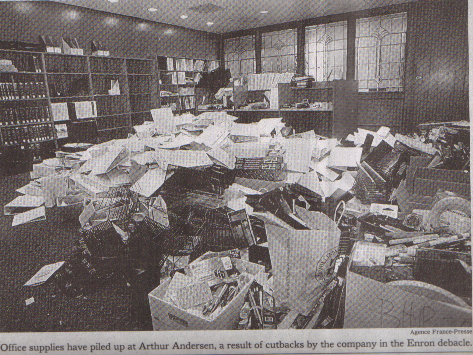The New York Times
June 17, 2002,
Monday, Late Edition - Final
Section A;
Page 14; Column 1; National Desk
ENRON'S
MANY STRANDS: THE DELIBERATIONS;
Jurors Tell
of Emotional Days in a Small Room
By JONATHAN
D. GLATER with JOHN SCHWARTZ
HOUSTON, June
16, 2002
|
This morning, juror No. 10
called the jewelry store where she works and said she would not be back
until Tuesday.
"I said I couldn't come in,"
the juror, Wanda McKay explained in a telephone interview today, a day
after the guilty verdict in the Arthur Andersen case was announced. She
was worried, she said, that she could not get through the day without
crying, after the jury found Andersen guilty of obstruction of justice
for altering documents related to Enron.
It was not the shredding of
documents at Andersen's Houston office that proved to be decisive, Ms.
McKay said, but evidence about the efforts of Nancy Temple, a lawyer with
Andersen, to revise a single memorandum.
|
 |
***
The nine men and three women charged
with deciding the case began deliberations every morning with a prayer. An initial
poll on the first day showed that four thought the firm was innocent, four thought
it guilty and four were undecided.
The foreman then took over, jurors
said, painstakingly leading them in the first few days through the instructions
given by Judge Melinda F. Harmon, who presided over the trial. Ultimately those
instructions -- which required the jury to find the firm guilty if it found
that one person had persuaded others to alter or destroy a document in order
to impede an official proceeding like a Securities and Exchange Commission investigation
-- were fatal to Andersen, Ms. McKay and Ms. Sorrell said.
***
Initially Ms. McKay said she was
convinced the firm was innocent.
The jury quickly discounted the testimony
of several witnesses and focused on those who struck them as credible and reliable.
John Stewart, an Andersen partner who was responsible for resolving complex
accounting questions, seemed the most believable, jurors said. The jury spent
several hours analyzing what Mr. Stewart said about his conversations with Ms.
Temple, the Andersen lawyer who the jury concluded had persuaded other employees
to alter or destroy documents.
Mr. Stewart, however, wanted to preserve
his documents, Ms. Sorrell said, in order to show that Andersen accounting experts
had reviewed certain Enron transactions. "He just seemed like a straightforward
guy. We knew we could rely on his testimony," she said.
***
Several jurors said that proposed
revisions by Ms. Temple, the Andersen lawyer, to an Andersen memorandum that
described some concerns about the accounting treatment of certain Enron transactions
were the decisive evidence.
"When we looked at the Nancy Temple
stuff, and with the instructions that the judge gave us, there was no way we
could not find Arthur Andersen guilty," Ms. McKay said. On Thursday morning
the jury had asked the judge whether they had to agree on the identity of the
person at fault in order to convict the firm, but by the time an answer came
on Friday afternoon, the issue was moot, she said.
"Nancy Temple was found guilty of
altering one document," she said, adding that she had known before the trial
that Ms. Temple had asserted her Fifth Amendment right not to testify. "One
person did one thing and tore the whole company down."
